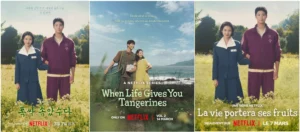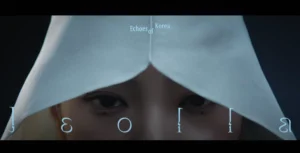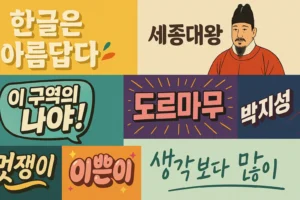During the time when people’s activities were restricted and international travel was halted due to COVID-19,
a new way of cultural communication began in Korea.
The Korea Tourism Organization found a way to digitally convey the charm of Korea to people around the world who had to stay at home.
The goal was to make it possible to feel Korea even when travel was impossible.
Though time has passed, I wanted to share this again with many people, so I’ve reorganized it.
Part 1: Korean Culture Meets a New Rhythm
Before 2020, the global tourism market was highly competitive. Korea saw an increase in visitors thanks to the popularity of K-pop and dramas, but it also needed to showcase new attractions to stand out among other Asian countries. The COVID-19 pandemic changed everything. As travel worldwide came to a halt, Korea’s tourism industry suffered a severe blow, and traditional tourism promotion methods became ineffective. The Korea Tourism Organization (KTO) set a goal: when people could travel again, Korea should be the first destination that comes to mind.
The pandemic was a crisis, but also an opportunity. Even when travel was impossible, Korea’s tourism industry found ways to connect emotionally with people. The answer was YouTube. They chose to communicate through music and dance—content that anyone can relate to—creating a strategy to connect with people worldwide. This led to the birth of the ‘Feel the Rhythm of Korea’ campaign.
This campaign was developed jointly by the Korea Tourism Organization and the advertising agency HS Ad. Unlike traditional promotional videos, this was not just an introduction to tourism but a cultural content piece designed for enjoyment. The videos were optimized for home viewing, giving viewers the feeling of traveling in Korea.
The success of this project was made possible by creative collaboration between public institutions and private companies. The Korea Tourism Organization granted creative freedom to the private agency, and HS Ad uncovered Korea’s subculture and ‘hip’ elements, turning them into engaging content. Through this process, the campaign conveyed Korea’s genuine charm and unique rhythm naturally to people around the world.
Part 2: Deconstructing the ‘Rhythm’—Seasonal Analysis
The YouTube series consists of four seasons, each briefly explained with links to the videos included. I will leave the evaluation of the entire campaign to you. Let’s take a look.
2.1 Season 1 (2020-2021): The Rise of Avant-Garde
The first season’s explosive success was driven by an unprecedented collaboration between the alternative pop band Leenalchi and the contemporary dance company Ambiguous Dance Company. Musically, Leenalchi reinterpreted Korea’s traditional pansori, especially ‘Sugungga,’ in a modern style. They combined traditional vocalists with drums and two bass guitars to create a groovy rhythm. This fusion broke the stereotype that Korean traditional music (국악) is heavy and dull. Visually, the choreography by Ambiguous Dance Company was so inventive and free-spirited it was described as ’21st-century dokkaebi (goblins),’ completely breaking away from traditional or commercial dance norms. The dancers wore modern outfits like training clothes and sunglasses while performing against traditional backgrounds, creating a striking visual contrast that left a deep impression.
The initial videos, released on July 29, 2020, featured Seoul (‘Beom Naeryeonda’), Busan (‘Eoryudo-gam’), and Jeonju (‘Jwau na jor’). Later, on October 13, 2020, videos for Andong, Mokpo, and Gangneung were released. The season concluded with an Incheon episode on March 21, 2021, featuring cast members from the popular variety show ‘2 Days & 1 Night,’ adding broad appeal. Behind-the-scenes footage and interviews with Leenalchi about their creative process and the campaign’s success were also shared to encourage audience participation.
2.2 Season 2 (2021-2022): Reinterpreting Hip-Hop
Following the viral success of Season 1, the campaign faced the challenge of maintaining freshness. Season 2 shifted focus to Korea’s other major cultural sphere: Hip-Hop and R&B. The Korea Tourism Organization partnered with leading Korean hip-hop labels like H1GHR MUSIC and AOMG. The concept involved star producers like GroovyRoom and Gray reinterpreting Korean traditional folk songs with modern hip-hop beats.
Aesthetically, this season embraced ‘grit and authenticity,’ contrasting with previous polished, modern tourism ads. It deliberately highlighted ‘places that didn’t receive much attention in the past’ and evoked nostalgia for the 1990s. The season also linked various regions and artists thematically:
– Seoul: pH-1 (‘Sarangga’), GEMINI (‘Arirang’)
– Seosan: Woogie Gochild (‘Ongheya’), inspired by the movie ‘Mad Max’
– Gyeongju & Andong: Woongjae & Sogum (‘Ganggangsullae’)
– Gangneung & Yangyang: JAY B (‘Nilliliya’), highlighting surfing culture
– Suncheon: TRADE L (‘Saetaryeong’)
– Daegu: BIG Naughty (‘Kkwaeji-na Ching-ching-nae’)
– Mokpo: Mamison (‘Pungnyeon-ga’)
– Jeonju: Wonstein (‘Taepyeongga’)
The campaign didn’t stop there; in May 2022, additional episodes featuring Yeosu and Pyeongchang expanded the musical spectrum to include orchestral and piano performances.
2.3 Special BTS Edition (2022): Meeting a Global Superstar
As international travel resumed, the Korea Tourism Organization launched a special mini-series titled ‘Feel the Rhythm of Korea with BTS,’ leveraging the global influence of the world-famous K-pop group BTS. The videos began with BTS members Suga and Jimin discovering classic K-pop songs from different eras inside an old cassette tape collection. Each song was paired with a region that best suited its genre and mood, creating a music video that connected past and present Korean culture.
– Busan (Blues): ‘Come Back to Busan Port’ by Cho Yong-pil (1972)
– Daejeon (Rock): ‘Encountered You’ by Song Gol-mae (1982)
– Pohang (Hip-Hop): ‘Do You Know Hip-Hop?’ by Drunken Tiger (1999)
– Jeju (Jazz): ‘The Wind is Blowing’ by Park Sung-yeon (2016)
This campaign achieved tremendous success, with YouTube views surpassing 490 million—far exceeding the initial goal of 310 million. It received 960,000 likes and 17,000 comments, with the Busan episode alone hitting 4 million views on its first day.
 Feel the Rhythm of Korea with BTS – BUSAN BLUES |
 Feel the Rhythm of Korea with BTS – DAEJEON ROCK N ROLL |
 Feel the Rhythm of Korea with BTS – POHANG HIPHOP |
 Feel the Rhythm of Korea with BTS – JEJU JAZZ |
2.4 Ongoing Evolution (2023—Present): NewJeans and ‘Koreans’ Korea’
Following BTS, K-pop girl group NewJeans was appointed as Korea’s honorary tourism ambassadors. The campaign further evolved into a new theme called ‘Koreans’ Korea,’ focusing on authentic experiences recommended by locals, moving beyond staged tourist spots to showcase real Korean life.
 [Feel the Rhythm of Korea with NewJeans] K-Food |
 [Feel the Rhythm of Korea with NewJeans] K-Food (Muslim Ver.) |
 [Feel the Rhythm of Korea with NewJeans] K-Experience |
|
The new series centered around Korean words like Gil (길, road), Bam (밤, night), Moheom (모험, adventure), and Shwim (쉼, rest), highlighting activities and atmospheres available in various regions. Videos featuring NewJeans showcased trending ‘experiences’ among young Koreans—such as K-idol experiences, personal color diagnostics, photo booths, e-sports tournaments, and rural vacations (촌캉스)—marking a paradigm shift from merely promoting places to promoting genuine experiences.
 Feel the Night (bam) of KOREA |
 Feel the Trail (gil) of KOREA |
 Feel the Rest (shwim) of KOREA |
 Feel the Adventure (moheom) of KOREA |
This is Korean culture.























